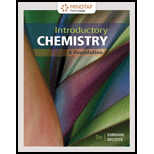
Concept explainers
(a)
Interpretation:
The pH of solution should be calculated. If the solution is acidic, neutral or basic should be indicated.
Concept Introduction:
The concentration of hydrogen ions in a solution determines the acidity of a solution. If concentration of hydrogen ion is more than the solution is more acetic, if it is low, solution is less acidic.
The pH of solution is defined as negative log of hydrogen ion concentration thus, it can be calculated as follows:
Here,
Similarly, pOH of a solution is defined as negative log of hydroxide ion concentration thus, it can be calculated as follows:
Here,
pH and pOH of a solution are related to each other as follows:
In a pH scale, if the value of pH is below 7 the solution is said to be acidic in nature, if the pH value is above 7 it is said to be basic in nature. At pH 7, the solution is neutral.
(b)
Interpretation:
The pH of solution should be calculated. If the solution is acidic, neutral or basic should be indicated.
Concept Introduction:
The concentration of hydrogen ions in a solution determines the acidity of a solution. If concentration of hydrogen ion is more than the solution is more acetic, if it is low, solution is less acidic.
The pH of solution is defined as negative log of hydrogen ion concentration thus, it can be calculated as follows:
Here,
Similarly, pOH of a solution is defined as negative log of hydroxide ion concentration thus, it can be calculated as follows:
Here,
pH and pOH of a solution are related to each other as follows:
In a pH scale, if the value of pH is below 7 the solution is said to be acidic in nature, if the pH value is above 7 it is said to be basic in nature. At pH 7, the solution is neutral.
(c)
Interpretation:
The pH of solution should be calculated. If the solution is acidic, neutral or basic should be indicated.
Concept Introduction:
The concentration of hydrogen ions in a solution determines the acidity of a solution. If concentration of hydrogen ion is more than the solution is more acetic, if it is low, solution is less acidic.
The pH of solution is defined as negative log of hydrogen ion concentration thus, it can be calculated as follows:
Here,
Similarly, pOH of a solution is defined as negative log of hydroxide ion concentration thus, it can be calculated as follows:
Here,
pH and pOH of a solution are related to each other as follows:
In a pH scale, if the value of pH is below 7 the solution is said to be acidic in nature, if the pH value is above 7 it is said to be basic in nature. At pH 7, the solution is neutral.
(d)
Interpretation:
The pH of solution should be calculated. If the solution is acidic, neutral or basic should be indicated.
Concept Introduction:
The concentration of hydrogen ions in a solution determines the acidity of a solution. If concentration of hydrogen ion is more than the solution is more acetic, if it is low, solution is less acidic.
The pH of solution is defined as negative log of hydrogen ion concentration thus, it can be calculated as follows:
Here,
Similarly, pOH of a solution is defined as negative log of hydroxide ion concentration thus, it can be calculated as follows:
Here,
pH and pOH of a solution are related to each other as follows:
In a pH scale, if the value of pH is below 7 the solution is said to be acidic in nature, if the pH value is above 7 it is said to be basic in nature. At pH 7, the solution is neutral.
Want to see the full answer?
Check out a sample textbook solution
Chapter 16 Solutions
Introductory Chemistry
- K Draw the starting structure that would lead to the major product shown under the provided conditions. Drawing 1. NaNH2 2. PhCH2Br 4 57°F Sunny Q Searcharrow_forward7 Draw the starting alkyl bromide that would produce this alkyne under these conditions. F Drawing 1. NaNH2, A 2. H3O+ £ 4 Temps to rise Tomorrow Q Search H2arrow_forward7 Comment on the general features of the predicted (extremely simplified) ¹H- NMR spectrum of lycopene that is provided below. 00 6 57 PPM 3 2 1 0arrow_forward
 Chemistry: The Molecular ScienceChemistryISBN:9781285199047Author:John W. Moore, Conrad L. StanitskiPublisher:Cengage Learning
Chemistry: The Molecular ScienceChemistryISBN:9781285199047Author:John W. Moore, Conrad L. StanitskiPublisher:Cengage Learning Chemistry & Chemical ReactivityChemistryISBN:9781337399074Author:John C. Kotz, Paul M. Treichel, John Townsend, David TreichelPublisher:Cengage Learning
Chemistry & Chemical ReactivityChemistryISBN:9781337399074Author:John C. Kotz, Paul M. Treichel, John Townsend, David TreichelPublisher:Cengage Learning Chemistry & Chemical ReactivityChemistryISBN:9781133949640Author:John C. Kotz, Paul M. Treichel, John Townsend, David TreichelPublisher:Cengage Learning
Chemistry & Chemical ReactivityChemistryISBN:9781133949640Author:John C. Kotz, Paul M. Treichel, John Townsend, David TreichelPublisher:Cengage Learning Chemistry: An Atoms First ApproachChemistryISBN:9781305079243Author:Steven S. Zumdahl, Susan A. ZumdahlPublisher:Cengage Learning
Chemistry: An Atoms First ApproachChemistryISBN:9781305079243Author:Steven S. Zumdahl, Susan A. ZumdahlPublisher:Cengage Learning Chemistry by OpenStax (2015-05-04)ChemistryISBN:9781938168390Author:Klaus Theopold, Richard H Langley, Paul Flowers, William R. Robinson, Mark BlaserPublisher:OpenStax
Chemistry by OpenStax (2015-05-04)ChemistryISBN:9781938168390Author:Klaus Theopold, Richard H Langley, Paul Flowers, William R. Robinson, Mark BlaserPublisher:OpenStax General, Organic, and Biological ChemistryChemistryISBN:9781285853918Author:H. Stephen StokerPublisher:Cengage Learning
General, Organic, and Biological ChemistryChemistryISBN:9781285853918Author:H. Stephen StokerPublisher:Cengage Learning





